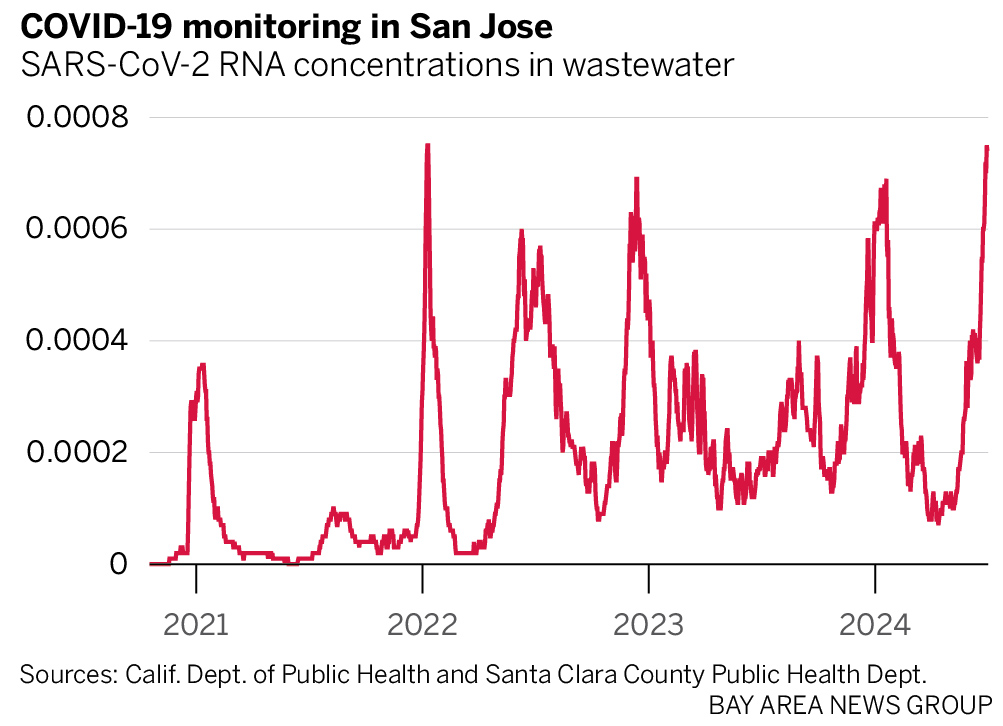If you thought COVID was a thing of the past, this summer’s surge should make you think twice. The entire Bay Area now seems to be infected with the virus.
Local data shows the virus is spreading widely in San Jose and most communities around the Bay Area and California. But despite near-record levels of COVID in wastewater and rising positivity rates, other statistics show much has changed and confirm that the virus is not nearly as deadly as it once was before vaccines and treatments became widely available.
Wastewater data for San Jose shows the virus reached near-record levels in the city’s sewer system this week, falling within a tenth of a percent of the previous record high, set during the first Omicron surge in January 2022. Santa Clara County’s three other sewer systems — Palo Alto, Sunnyvale and Gilroy — all also have high COVID levels, dating back to the first few days of July.
COVID levels are also rising in the East Bay as more people contract the virus. Alameda County public health officials said this week that wastewater was showing an increase in the virus and urged people to take precautions.
Across the state, the COVID positivity rate—the portion of COVID tests that come back positive—began rising in June. On June 1, the positivity rate was 4.1%. It more than doubled to 10.6% by July 1, according to data released Friday. The state is now within one percentage point of where it was during this winter’s COVID peak, when it was just over 11%.
The wastewater data shows what doctors and healthcare professionals see every day.
“We clearly have a surge of cases now,” said Dr. John Swartzberg, a clinical professor emeritus of infectious diseases and vaccinology at UC Berkeley’s School of Public Health. “Test positivity is going up dramatically, emergency department visits are going up, hospitalizations are going up. All of that tells us there’s a hell of a lot of COVID going on.”
“This is the most dramatic period we’ve had with COVID since the winter peak, but compared to a year ago we’re in a better position,” he said.
While the danger to most people is now negligible, Swartzberg worries about those most at risk.
“The message I would like to get out to the public is that there is a tremendous amount of COVID circulating,” he said. “If you are at high risk, you need to take precautions.”
This also means that you should get vaccinated if you have not recently had a shot.
That’s consistent with what Dr. Peter Chin-Hong, a professor of medicine at UC San Francisco who specializes in infectious diseases, recently saw at his hospital.
“The data has been consistent over the last year or so. The people in the hospital are generally over 75 or have very weakened immune systems,” he said.
And they have something else in common: “No one I’ve seen has gotten the vaccine since it came out in the fall.”
A newly formulated vaccine was released last fall, and people at high risk can and should get a booster between new annual shots, Swartzberg said. It’s not too late to get a booster this summer if you’re at high risk, and you’ll still be eligible for another shot in the fall.
The now annual reformulation of the COVID vaccine is expected in August or September and will be based on one of the more recent FLiRT variants, after some back-and-forth between the FDA and its vaccine advisory committee.
While people at high risk may choose to take precautions during this summer’s peak, there are also reassuring statistics that show COVID now is a different beast than COVID during the early days of the pandemic in 2020.
“If we had seen this much COVID wastewater in 2020, our hospitals would be bursting at the seams,” Chin-Hong said. “The fact that we are seeing so much in the wastewater and only a modest increase in hospitalizations is because the population is generally much more immune than in previous years.”
And while deaths have increased slightly in recent weeks, COVID accounts for only about 1% of California’s deaths as of late June, the most recent data available. That’s still far lower than the 3.5% this January during the winter peak, and well below January 2021, the first winter peak, when 40% of all California deaths were due to COVID.
Before this summer spike in deaths, the COVID-19 rate was hitting new lows. It has been well below 1% since March of this year. That is the lowest level since the start of the pandemic.
“I think people are missing the fact that it’s easy to get COVID,” said Swartzberg, who has been dining out more and wearing a mask indoors. “It’s almost a perfect storm of incredibly contagious variants, a population that’s not taking precautions, and waning immunity.”
